106.3.2.59 TM-59, Determination of the International Roughness Index
This method describes the procedure for determining the International roughness index (IRI) of pavement surfaces in English units.
106.3.2.59.1 Equipment
Inertial Profiler. The International roughness index (IRI) shall be measured with an inertial profiler (IP). The IP shall meet the equipment requirements of AASHTO M 328, which include the following three primary transducers: (1) a height sensor that measures the distance between the pavement and a vehicle reference point, (2) an accelerometer that measures the vehicle vertical acceleration in response to the pavement profile and (3) a distance sensor that provides a location reference as the vehicle moves longitudinally (see Fig. 106.3.2.59.1). The IP shall also be equipped with an automated triggering system that can automatically start and stop data collection using a reference mark. The IP shall store the profile elevation data at an interval of 2 in. or less and have a vertical measurement resolution of 0.001 in. or less. The IP equipment may be either the low speed or high speed type. The IP shall be capable of exporting unfiltered raw profile data to a profilograph file (conforming to ASTM E 2560) that can be imported into the ProVAL software program.
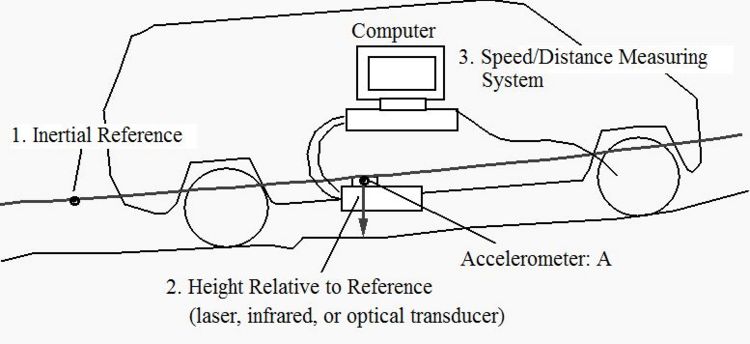
ProVAL. The profilograph file shall be evaluated using the ProVAL software program. ProVAL is a free program developed by The Transtec Group under contract with the FHWA. The current program version is ProVAL 3.3 and can be downloaded.
106.3.2.59.2 Inertial Profiler Certification Procedures
Each IP used for construction acceptance testing on a MoDOT project shall be annually certified (verified) at the Linn State Technical Colleg test site. The test site will have a known IRI in two wheel paths, measured with a reference profiler.
The inertial profiler (IP) shall have its low- and high-pass filters set to zero prior to the certification test. The IP shall have any other controls set according to manufacturer’s specifications. The two sensors in the profiler shall be spaced 6 ft. apart.
The IP operator may perform trial profile runs prior to the certification testing. The IP shall start far enough in advance of the test section to reach data collection speed. The IP operator shall perform five profile runs on the test section collecting data in both wheel paths. The IP shall move at a constant speed over the test section. An IP with two sensors shall measure both wheel path profiles in a single pass. An IP with one sensor shall measure each wheel path profile individually. Upon completion of testing, the IP operator shall provide the engineer a summary printout in the IP company software format of IRI values in English units (inches/mile) for all tests and the unfiltered profiles in profilograph format on a readable electronic storage device such as a CD or flash drive. Each summary report shall contain the following:
- a) Date and time
- b) Operator identification
- c) Equipment owner
- d) Equipment identification for vehicle and IP equipment
- e) Unique number profile
- f) Software name and version
- g) Profiler settings for filters
- h) IRI values.
MoDOT will analyze the submitted data using ProVAL. The test results of the inertial profiler (IP) shall meet the following requirements:
- a) The IRI average of the five profiles shall be within 5 percent of the reference IRI value.
- b) The IRI standard deviation of the five profiles shall be no larger than 3 percent of the IRI average of the five profiles.
- c) Each individual IRI-filtered profile shall correlate with the reference IRI-filtered profile at a level of at least 85 percent.
- d) The average of the five profile correlations shall be at least 92 percent.
- e) Each individual profile length shall be within 0.2 percent of the actual test section length.
An inertial profiler (IP) that receives acceptable test results at the certification site shall be furnished with an annual IP certification decal. The date of acceptance, unique identification number, IP model and manufacturer, vehicle make and model to which the IP is attached, operational system software version, and signature of a MoDOT Construction and Materials Division Engineer will be shown on the decal.
106.3.2.59.3 Construction Acceptance Procedures
Testing Conditions. All objects and foreign material shall be removed from the pavement surface. There shall be no standing water in the wheel paths during testing.
Testing Limits. The inertial profiler shall measure the surface of a pavement section in both wheel paths, that are located 3 ft. from and parallel to the edges of the lane, running in the direction of travel.
- The starting point shall be 50 ft. before the start of the day’s paving.
- The starting point shall be a known station or logmile measured to the nearest foot.
- The IP shall use an automated triggering mechanism to initiate data collection at the starting point and end data collection at the ending point.
- The starting point shall be visibly marked for the duration of the project so that subsequent profile measurements may be closely matched.
Data Submittal. The contractor shall submit an electronic file in profilograph format containing the unfiltered raw data collected at the section. Data shall be submitted within 24 hours of the testing on each section. A day's report may consist of more than one section. Profilograph files with QC data results shall be submitted to MoDOT using the naming convention in Table 106.3.2.59.3.
| Electronic Profilograph File Naming Convention* | |
|---|---|
| Abbreviation | Definition |
| YYMMDD-###_ | Contract ID (Letting Date-Call Number) |
| YYMMDD_ | Test Date |
| Q_ | Type of quality test (C for control, A for assurance) |
| D | Direction of Lane (N,E,W or S) |
| L | Lane number (1 for driving lane, increasing by one for each lane to the left) |
| W | Wheel path (L, R, or B) |
| S | Beginning Station (rounded to nearest foot) |
| * Example: 100528-501_111103_C_N2R105045.PPF | |
Data Analysis. After the profile data for a section of pavement has been collected, the contractor shall use the ProVAL program to analyze the results using the same unfiltered profilograph data file that was submitted to MoDOT. ProVAL shall be used for both quality control and quality assurance test data. The analysis will consist of two primary components [1] segment smoothness evaluated with the "Ride Quality" module and [2] areas of localized roughness (ALR) evaluated with the "Smoothness Assurance" module. The contractor shall submit hardcopy of the ProVAL summary report in pdf file format to the engineer within seven calendar days of the profile data collection.
106.3.2.59.3.1 Segment Smoothness
The data will first be analyzed for ride quality, which will determine the average IRI for each wheel track on a per segment basis. The steps are as follow:
- Open ProVAL program.
- Select "New".
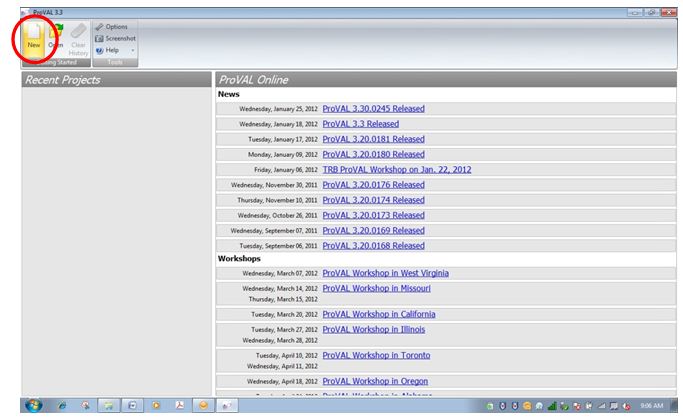
- Select "Add Files" to import PPF file with QC/QA profile data.
The file(s) will either be a single one containing both right and left wheel track profiles or a pair of files with each containing one of the wheel track profiles.
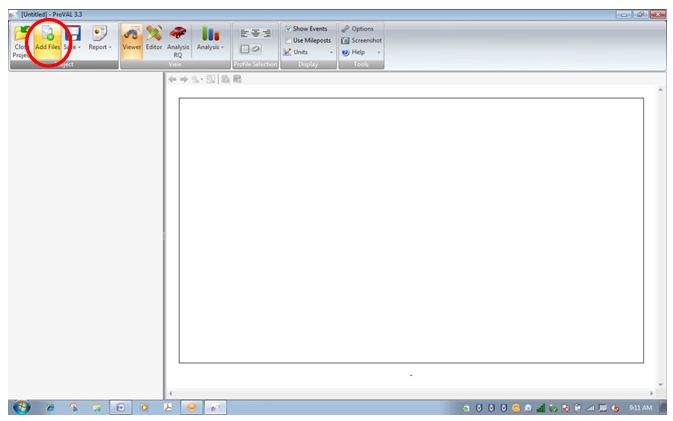
- Select left elevation and right elevation.
The program will correctly align separate files with each other, provided the data collection was initiated at the same starting station for both files.
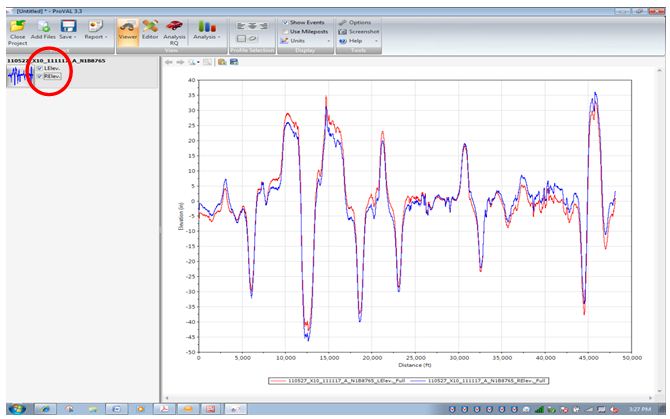
- Select "Ride Quality" in the "Analysis" module.
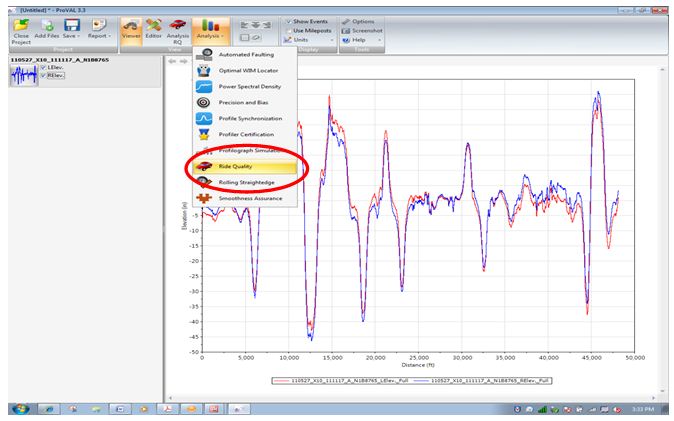
- Select "Fixed Interval" in the "Analysis Type" dropdown box.
- Change "Threshold" limit to 80 (in/mi). The "Segment Length" should show the default value of 528 ft. and the "Ride Quality Index" should show the default name of "IRI".
- Check box for "LElev." and "RElev." and make sure the "Apply 250mm Filter" box is checked for both.
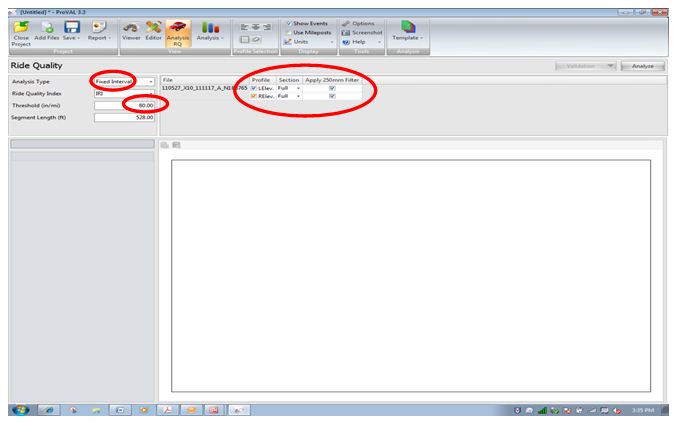
- Select "Analyze".
The average IRI of a wheel path for each 528 ft. long segment will be shown on the screen. The drop down menu above table at left can be used to view either left or right wheel path IRI values
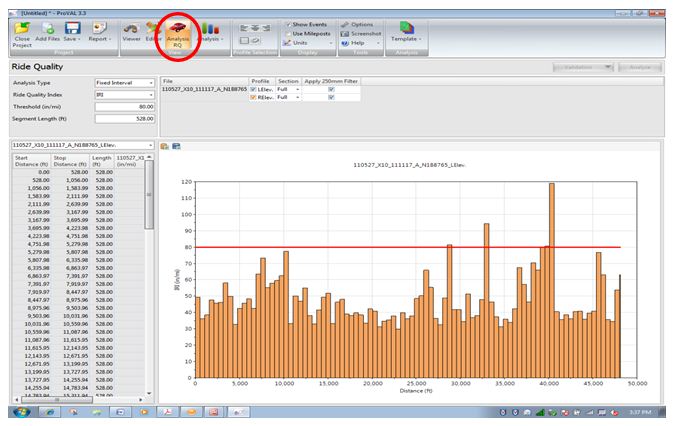
- Select "PDF" in "Report" dropdown box.
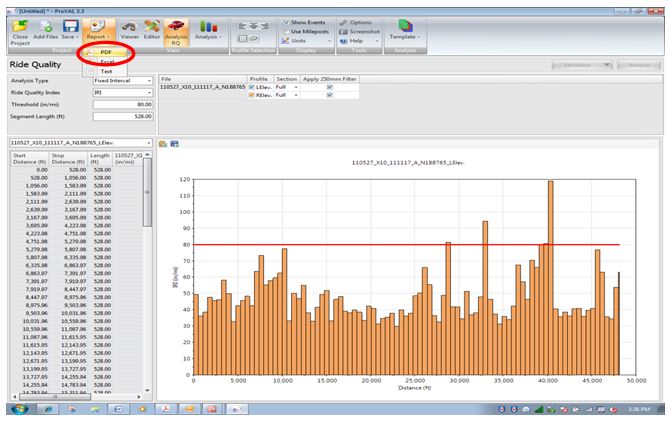
Average IRI over a 528 ft long segment for each wheel track is listed in the report table.
- Manually enter this data into the IRI Summary Worksheet.
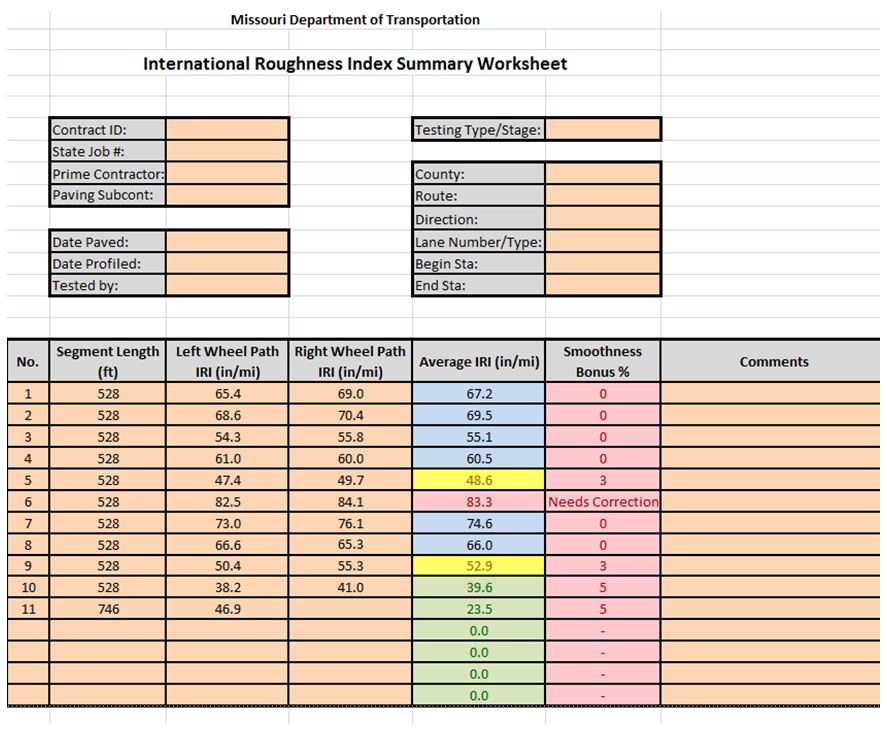
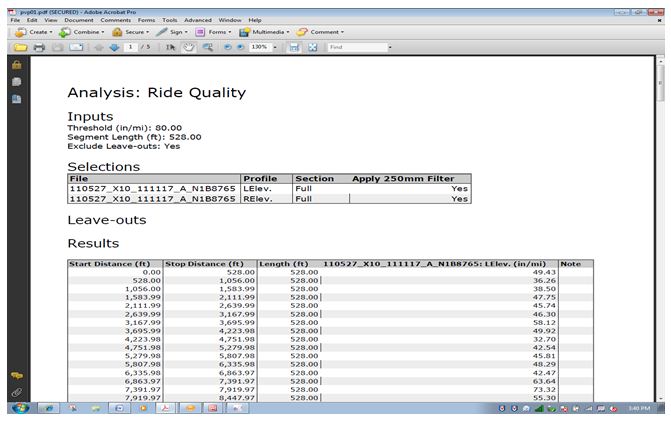
- Save a copy of the Ride Quality report in the CIA project folder.
There may be exempted areas per Sec 601.4.2.2 within the section profile limits. The engineer should verify that the limits do not go beyond the eligible exemption area. The contractor may elect to:
- 1) Stop the profile run at the beginning of the exemption and begin a new section profile at the end of the exemption.
- 2) Manually enter exemption boundaries in the data acquisition software during the profile run (typically performed with high speed IPs).
- 3) Enter a "leave-out" area in ProVAL during the ride quality analysis. The instructions for performing this are as follows:
- Select "Editor". Select the file from the File dropdown menu.
- Select "Sections" in the "Navigate" drop down box.
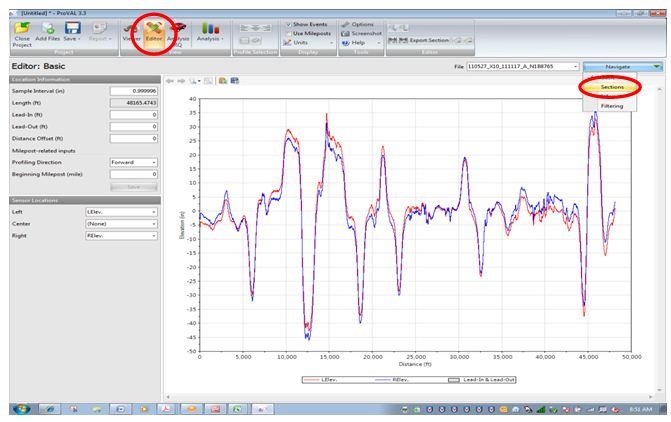
- Select "Add Section".
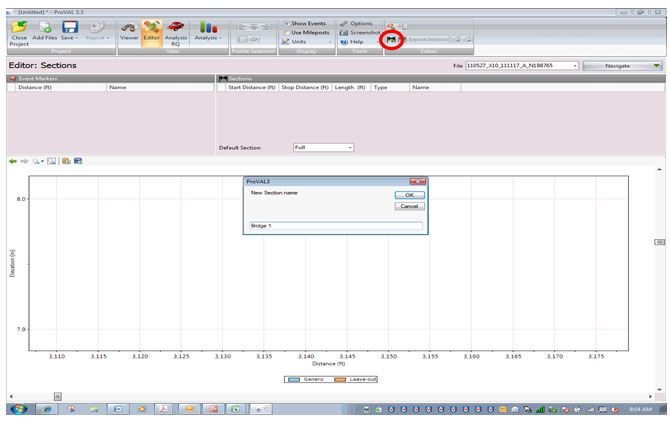
- Enter section(s) Start Distance, Stop Distance, Type (Leave-out) and Name.
- Select "Analysis" and select "Ride Quality".

The ride quality summary shown below now excludes the exempted areas of the profile and abbreviates the associated segments accordingly.
106.3.2.59.3.2 Areas of Localized Roughness
- Select "Smoothness Assurance" in "Analysis" module.
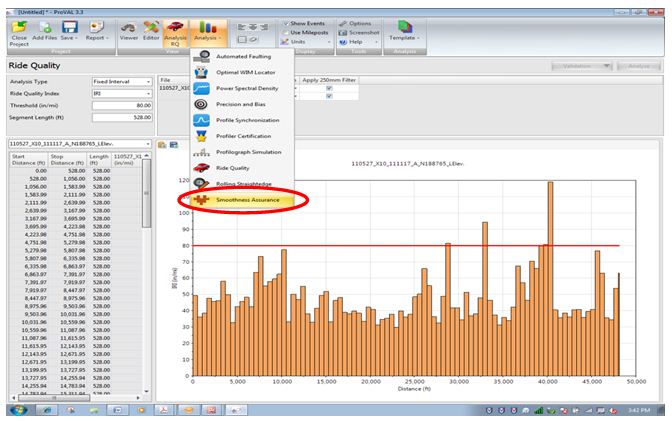
- Change "Threshold" value to 125 (in/mi) for "Short Continuous" analysis in the "Ride Quality" section. (The segment length for "Short Continuous" should be set at the default value of 25 ft.)
- Check "Right Elevation" only in the "Profile" section (make sure "Apply 250mm Filter" is also checked).
- Change "Threshold" to 80 (in/mi) for "Long Continuous" and "Fixed Interval" in the "Profile" section. (The "Segment Length" should be set at the default value of 528 ft. for both "Long Continuous" and "Fixed Interval".)
- Select "Analyze".
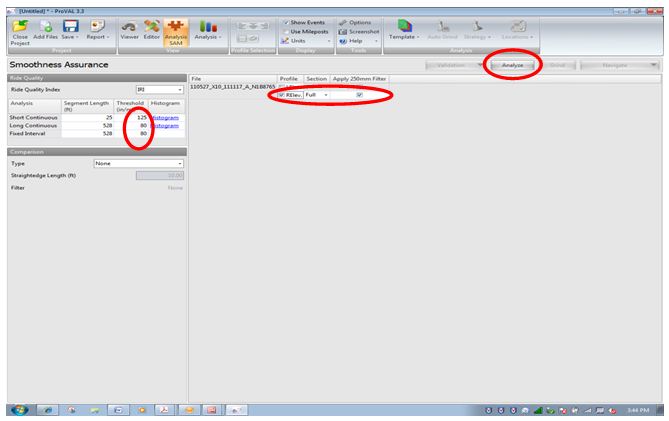
- Select "Grinding" in the "Navigate" dropdown box.
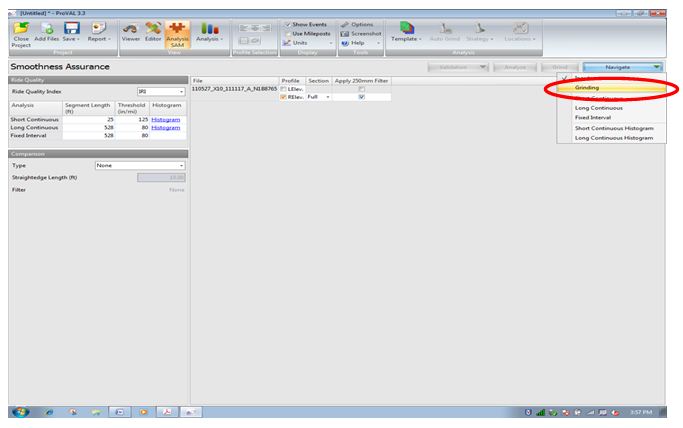
- Enter 0.25 inches for "Maximum Grinding Depth" in "Grinder" section. (The following parameters should show the default values, which are Head Position = 0.50, Wheelbase (ft) = 18, Tandem Spread (ft) = 2.49 and Short Cut-Off Wavelength (ft) = 0.82 ft.)
- Select "Auto Grind".
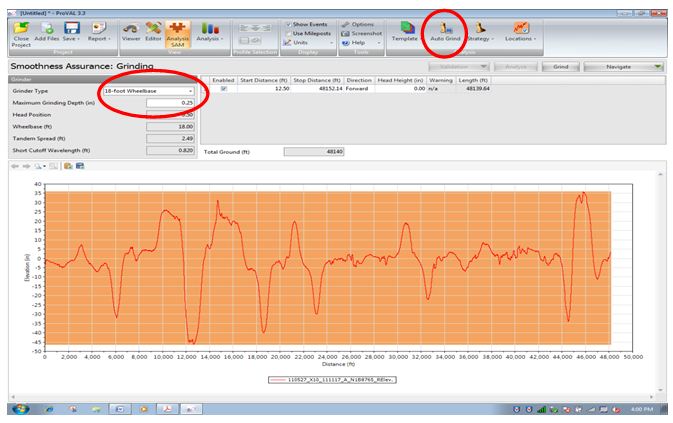
- Select "Grind".
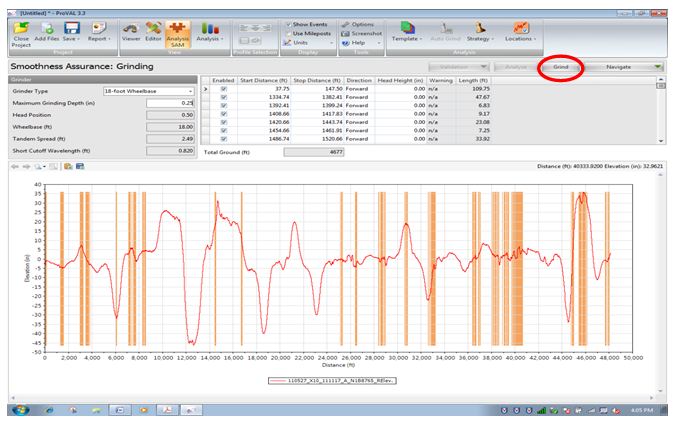
- Select "Short Continuous" in "Navigate" dropdown box.
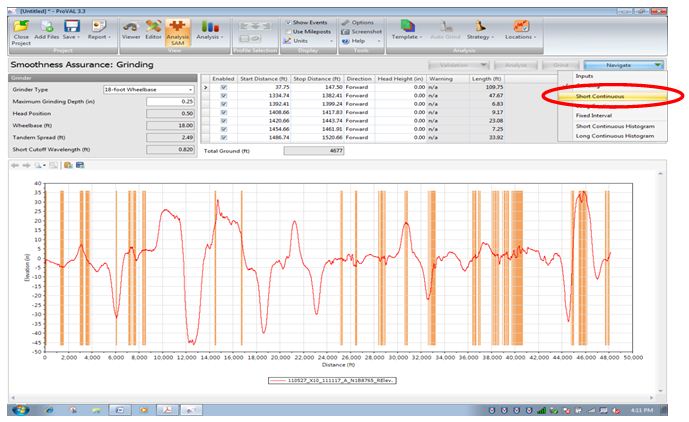
- Select "PDF" in "Report" dropdown box.
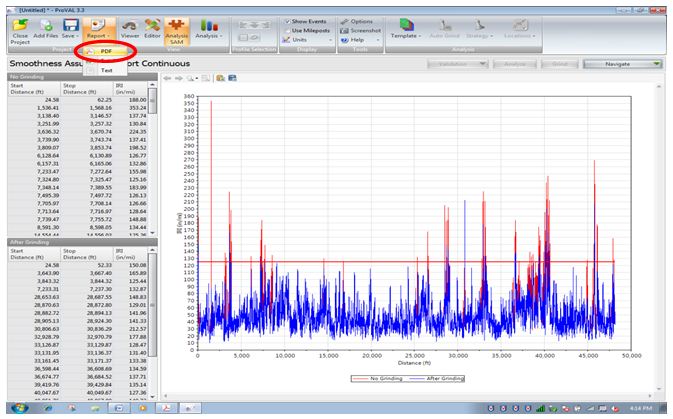
The grinding report is generated showing locations of areas of localized roughness (ALR). The grinding simulation numerically indicates what the expected improvement in smoothness should be when the ALRs are diamond ground. This information serves as a guide for both the contractor and the engineer for determining which ALRs can be corrected with conventional grinding and which may require other corrective measures.
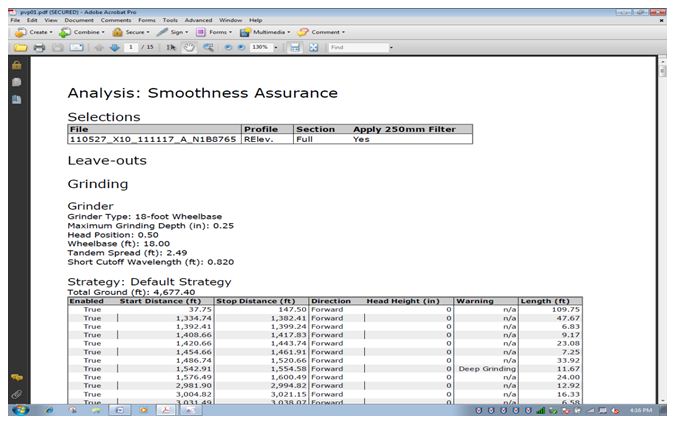
Comparisons for IRI before and after grinding are shown in tabular and bar graph form.
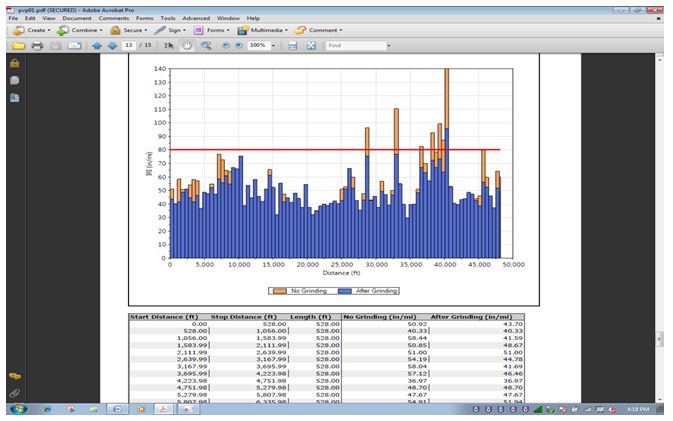
106.3.2.59.4 Dispute Resolution
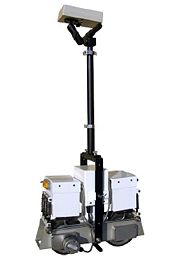
In the event that the QC/QA results are not within 6 inches/mile for each segment and the contractor disputes the results, the MoDOT reference profiler used for equipment certification shall arbitrate the dispute. A Construction and Materials Division tester shall randomly select a 528-ft. area within the disputed pavement length and run the MoDOT reference profiler in the left and right wheel paths. The arbitration profile shall be correlated with its corresponding QC and QA profiles in ProVAL. Whichever of the average QC/QA IRI profiles is closer to the arbitration IRI profile, up to a maximum difference of 6 inches/mile, shall be the binding profile for the purpose of construction acceptance.